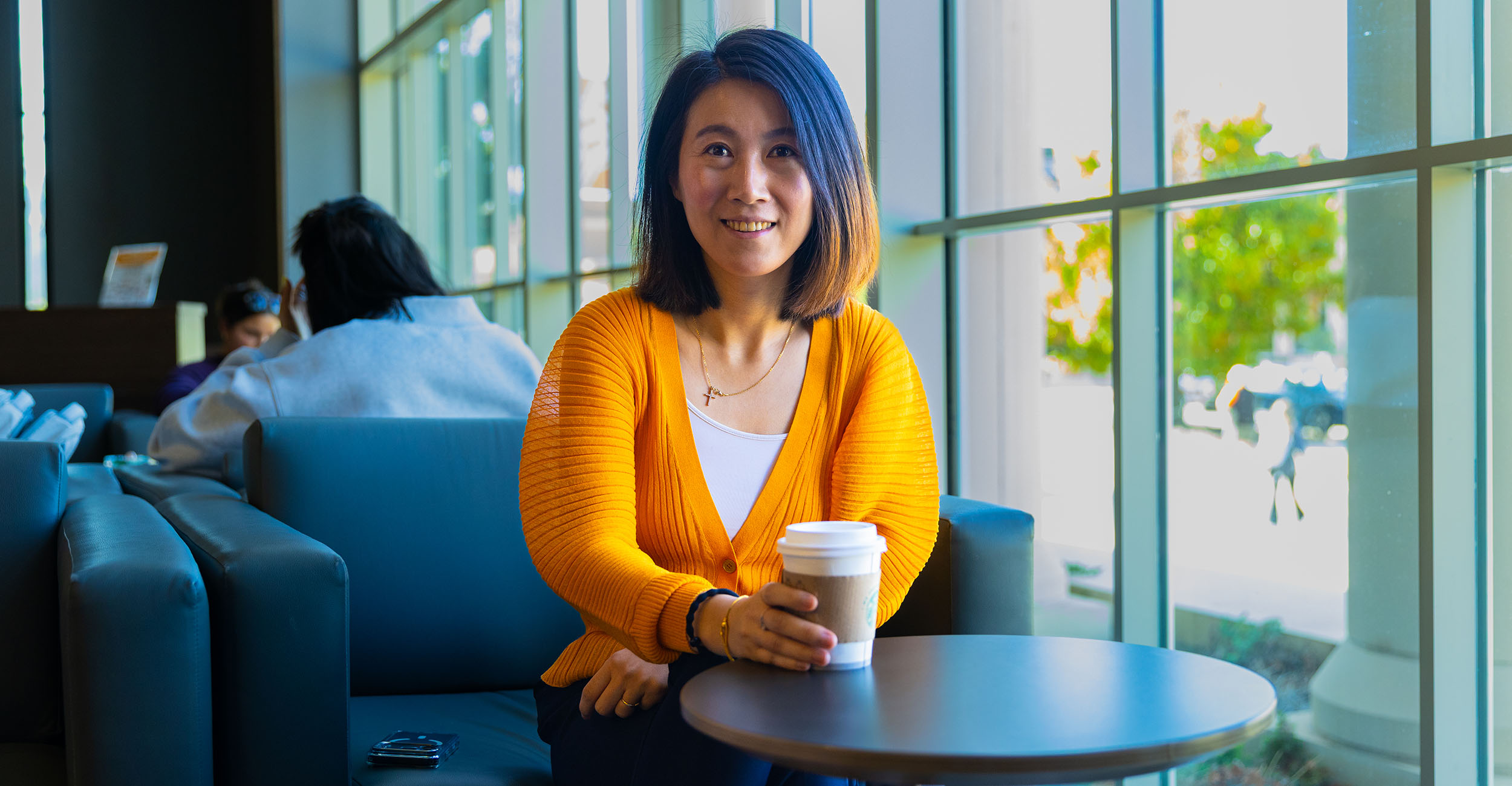
Spears Business assistant professor Wu’s research highlights solo consumers’ influence
Tuesday, November 4, 2025
Media Contact: Hallie Hart | Communications Coordinator | 405-744-1050 | hallie.hart@okstate.edu
A customer sits with friends inside a cozy café, where they chat about their day over steaming mugs of coffee and herbal tea.
Another customer enjoys a handcrafted latte at a table alone, listening to the music softly drifting through the coffeehouse speakers.
Both patrons recommend visiting. Which person’s online review would more likely affect your perception of the business?
In many cases, the solo consumer has more influence, according to Oklahoma State University researcher Dr. Yuechen Wu.
The Spears School of Business assistant professor of marketing shared her findings in the paper, “The Influential Solo Consumer: When Engaging in Activities Alone (vs. Accompanied) Increases the Impact of Recommendations.”
Co-authored with Dr. Rebecca K. Ratner, Dean’s Professor of Marketing in the University of Maryland’s Robert H. Smith School of Business, the publication appears in a forthcoming edition of the prestigious Journal of Marketing Research.
Wu and Ratner highlight the effect of social context on our perceptions of consumer recommendations. Their findings indicate people often view solo consumers as more interested in an activity and attuned to its quality than accompanied consumers are, whether watching a movie, exploring a museum or visiting a café. Perceived intrinsic interest is a key to influence, according to the research.
“If you think I’m interested, I’m more involved and engaged with the experience, and I may notice different aspects of the experience that I can share with other people,” Wu said. “I can have a more insightful recommendation than people who are not that interested and may not pay that much attention to the activity.”
People tend to wonder if companionship could distort someone’s review, whether positive or negative. A slightly stale cup of joe doesn’t seem so bad when you’re laughing with friends, but if you’re alone, you might notice that unpleasant taste. On the contrary, while you delight in the perfect cappuccino by yourself, you might ignore its greatness on an awkward date.
What does this mean for marketers?
Wu and Ratner’s research indicates even when readers are planning group activities, solo consumers’ reviews tend to hold more weight. This has significant implications for advertisers and marketers, who rely heavily on word of mouth. While marketing campaigns often focus on families, friend groups and couples, should these efforts increasingly target single, independent consumers?
Wu emphasizes balance. There are certain cases where group reviews offer unique benefits, such as specifying whether an activity is family-friendly or boring for kids. Still, the solo consumer is typically underrepresented in testimonials on businesses’ websites, meaning marketers likely miss opportunities to reach key demographics.
First, businesses have to accommodate parties of one. If the only available seating in a coffeehouse is a table for six, an unaccompanied patron might feel awkward.

“Many venues don’t facilitate solo consumption,” Wu said. “They are starting to do that. For example, in Japan, they now offer cubicles or individual seating, so you can go to a restaurant and sit at an individual table. If the solo consumers’ words are more valued, maybe marketers should also do something to facilitate, or at least make it more comfortable, for consumers to engage in solo activities.”
Wu often explores social factors that influence business. She recently collaborated with Spears Business associate professor Dr. Xiang Fang and former Spears Business faculty member Dr. Kevin Kam Fung So on the publication, “Beyond Money: How Social Motives Drive Green Purchases in the Sharing Economy,” which won the Best Competitive Paper Award at the 2025 Association for Consumer Research Conference. Another recent paper, “Who Will I Be With(out) You? Consequences of Perceived Romantic Relationship Status Stability on Product Rentals,” appears in the Journal of Marketing Research.
Wu’s research on solo versus group consumers was inspired by personal experience. She has enjoyed many activities independently — dining, shopping and even taking a trip to the historic Forbidden City palace complex in Beijing. However, she noticed many people are self-conscious about public solo consumption, wondering if others label them as “losers.”
Research suggests those fears aren’t necessarily justified.
“They’re more open to new experiences,” Wu said. “They’re more curious. They want to explore the world more. That’s what other people think. At the same time, solo consumers are perceived to have fewer friends, but that negative inference doesn’t lower other people’s overall perception of solo consumers.”
How was the research conducted?
In Wu and Ratner’s dataset of more than 6,000 coffee and tea shop reviews on Tripadvisor.com, solo consumers were more likely than accompanied consumers to receive a higher number of thumbs-up reactions, indicating helpful testimonials. The same pattern emerged across thousands of reviews of the Smithsonian National Museum of Natural History. This trend appeared despite group consumers writing the majority of reviews.
A deeper analysis of coffee and tea shop reviews revealed solo customers used more ambiance-related words than family customers or those in couples did. These terms include “seating,” “music,” “lighting” and “decor.” Readers might perceive these lone patrons as more attentive to their environments than accompanied consumers are, establishing credibility.
“They also tend to be longer reviews,” Wu said. “They tend to have more photos.”
The solo consumer’s influence prevailed when Wu and Ratner surveyed undergraduate college students about social media posts endorsing two different movies.
One movie was mentioned in a post by a user who watched it alone, while the other was named in a post about a movie night with friends. The researchers then asked the students which film’s trailer they would prefer to see. Even when the location in the posts changed between watching the movie at home or in a theater, the trend remained consistent. Students showed more interest in whichever movie received praise from the solo viewer.
What does this mean for consumers?
This phenomenon translates to video-based platforms such as YouTube and TikTok, where travel and food reviewers gain millions of followers. Although popular creators occasionally feature friends or relatives in their videos, many appear on screen alone while biting into a pizza slice or settling into an airline seat. The lone narrator builds a reputation as an independent, trusted guide.
However, not every solo consumer’s review is believable. Websites can be littered with fake testimonials, and influencers get paid to write glowing reviews boosted by many thumbs-up reactions, though group consumers can do the same.
Even when a review is authentic, a solo consumer might engage in an activity for a business trip or class project instead of leisure enjoyment. Wu and Ratner found solo consumers’ influence decreases when they are perceived as less interested in the experience. Meanwhile, group consumers could increase their influence through stated interest in an activity, such as saying, “My husband and I are both history buffs, and we loved this museum.”
While exceptions exist, the solo consumer typically wins when it comes to perceived interest. Wu is conducting further research on consumers’ social experiences and openness to talk to strangers. In a world where people are increasingly lonely, solo consumption can actually create new connections, whether in person or online.
If you call your friends and they’re too busy to join you at the café down the street, it might be tempting to just stay home. Wu encourages otherwise.
“That doesn’t need to stop you,” Wu said. “Other people will not judge you the way you think you will be, and actually, your words can be more influential and you can be more engaged in the experience. Those are all benefits.”
Visit the website to learn more about Spears Business research.
